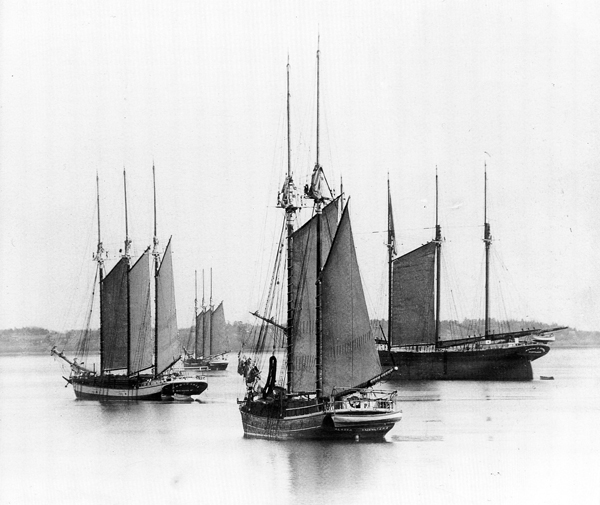B A C K T H E N
Peaks Island Roads

Peaks Island Roads, Portland Harbor, early 1900s. Four windbound coasting schooners lie at anchor. The Hortensia of Machias, loaded with spruce spiling, is at left. Built as a two-master at East Machias in 1868, she was rebuilt into a three-master about 1904. The two-master in the foreground is Alaska of Sackville, New Brunswick, laden with laths. Forward, her towing hawser is hoisted to dry; aft, her heavy mainsail is reefed, indicating she may be sailing shorthanded. The big four-master to the right is the Bath-built Alicia B. Crosby of Portland, of the J. S. Winslow fleet. Riding light, she has doubtless discharged a cargo of bituminous coal. The smaller schooners are likely headed to Boston, New York, or somewhere in between. The Crosby is ultimately headed back for a middle Atlantic coal port, although she may first load a return cargo of Kennebec River ice. Success in the command of a big and costly coal schooner required a certain degree of impatience; the many hazards of passage-making in such a vessel might keep an overly prudent man forever swinging at anchor. On June 15, 1897, the Argus reported that the Crosby, under Captain George W. Bunker, had entered Portland flying in before the wind:
The Crosby heeled over from the force of the gale almost like a yacht and threw the foam and spray in every direction. She was traveling at the speed of a racehorse as she came in past Spring Point Light, but she came to anchor as readily as though there had been merely an ordinary sailing breeze.
Time meant far less to the skipper of a small lumber schooner, whose great objective was to arrive at his destination in due course and in good order. The old Samuel Castner Jr. of Calais once took forty-two days to deliver a load of lumber to New York.
On April 23, 1902, the two-masted schooner Charles E. Spears of Lubec departed Calais for Newport, Rhode Island, with a cargo of hemlock boards. Joining her crew of five was young Frank Adams, grandson of the skipper. Sailed with due deliberation, the Spears, built in 1874, made Portland on May 3, her crew having eaten plenty of clams along the way. At Portland, Adams wrote in his diary:
May 5 .... Raining heavy. Water boat came along side to fill our casks ... after supper visited Captain Willis Wormell, a So. Lubec man, master of the four-mast schooner the Alicia B. Crosby. He insisted on me eating another supper with him. I did.
Thursday May 6. Under way early this morning, went only as far as Peaks Island Roads. Under way again after breakfast. 8:35 AM. Portland Head Light to starboard. 10:15 AM. Cape Elizabeth Lights to starboard. Wind ahead and light, going back in to the harbor, anchored again in the roads about noon. Went ashore to Peaks Island for the papers ....
On May 8 the weather broke, and the Spears left with a large fleet. That night the wind increased and shifted ahead, and by morning the schooner was running before a gale under but a headsail. In the afternoon, more sail could be made, and that night she had anchored inside Eastern Point, Gloucester, another favorite coaster haven. After rounding Cape Cod, and spending several days anchored at Vineyard Haven—the most famous of coaster resorts—Newport was finally won on May 14. The Spears then sailed to Perth Amboy to load coal, but, owing to the great coal strike, returned home light. That passage was made in less than fifty hours—the exhilaration of that wonderful sail Down East, with sheets eased and a long wake astern, helped erase the memory of the foregoing weeks of tedium. Tedium and exhilaration were both common to the coasting business.
The Crosby was a notably long-lived and successful schooner. Between January 1905 and May 1912, under Captain Frank Peterson of Machiasport, she made 109 voyages, primarily between Middle Atlantic coal ports and New England. Occasional voyages were also made to San Juan for sugar, and to Jacksonville, Galveston, and Sabine Pass, for lumber.
Captain Wormell was the last master of the five-masted schooner Carroll A. Deering. In January 1921 the Deering, returning from Rio, stranded on Cape Hatteras. Aside from the missing yawl boat, the schooner was in perfect order. The last log entry in Wormell’s hand was made a week before the stranding. Wormell had complained that the crew was the most unruly he had ever had.
Text by William H. Bunting from A Days Work, Part 1, A Sampler of Historic Maine Photographs, 1860–1920, Part II. Published by Tilbury House Publishers, 12 Starr St., Thomaston, Maine. 800-582-1899.
